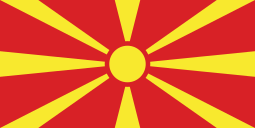Mini Schengen Zone
The Mini Schengen Zone is an Economic Zone between Serbia, Albania and North Macedonia. It was declared on October 10, 2019 in Novi Sad. Two more meetings were held, one in Ohrid on November 11, 2019 and the other in Durres on December 12, 2019. The three countries declared that they will form an unified market of 12 million people until the end of 2020. With this Union, goods between these three countries will flow quicker, people from these countries will be able to cross the border with ID only, and more than 30 million hours will be saved between the borders of these three countries every year. This economic Zone is preparing countries to become members of the European Union.[1][2]

Economy and Cities
The GDP of these countries united would be $79.613 bilion, GDP PPP would be $211.971 bilion. GDP per capita would be $6,694, GDP PPP per capita would be $17,700.Albania and North Macedonia will have higher GDP per capita and GDP PPP per capita than now,and Serbia will lose a bit of its average.Currencies are Serbian Dinar, Albanian Lek and Macedonian Denar. Official languages are Serbian language, Albanian language and Macedonian language. Capital cities are Belgrade, Tirana and Skopje. Some other big cities are Novi Sad, Nis, Durres, Shkodra, and Kragujevac. Serbia is the largest country in this Union, it also has the biggest economy, Human Development Index, and Population. The largest city in this Economic Zone is Belgrade, capital city of Serbia with about 1.7 milion people.
What the Mini Schengen Zone Does
The Mini Schengen Zone is providing trade, exchanging students, and boosting EU integrations in Member states. Citizens of Member states need only ID card for visiting other Member states. It will save time by stopping large columns at border crossings.
When Will the Mini Schengen Zone be Established
On October 10, 2019 the Mini Schengen Zone is declared by Serbia, Albania and North Macedonia. The next meeting is projected to be in Belgrade, in late spring or summer 2020. The first meeting was to be held in January or February 2020 in Belgrade, however, due to the COVID-19 pandemic, no new meeting was held, a potential date for new meeting in Belgrade is spring or summer of 2020. At that meeting leaders of those countries will say exactly what the Union will do, and how is it going to work. In the declaration of Mini Schengen, Serbia, Albania, and North Macedonia guarantee that by the end of 2020 they will make a Mini Schengen Zone, and make a free flow of goods and capital.
Potential Members
Potential Members are Montenegro and Bosnia and Herzegovina, President of Montenegro on Durres summit said that he supports this idea, but that Montenegro is only on the way to European Union. Representative of Bosnia and Herzegovina during the Ohrid summit said that Bosnia and Herzegovina is only on the way to the European Union, but that can change in the future, as she said. Both Montenegro and Bosnia and Herzegovina aren't in declaration, so they are potential members.
Potential Members which haven't sent anyone to meetings
Kosovo refused to go to any meeting, saying that it is not interested in this zone, because Serbia don't recognize Kosovo, however, that can change with new Assembly of the Republic of Kosovo. With dialogue being restored in May 2020, and Kosovo revoking the 100% tax on Serbian goods, Kosovo can become a new member of this economic zone.
Economy of Member States






- GDP growth:-1.8%(2020),7.5%(2021)
- Inflation:1.4%(2020)





- GDP Growth:-5%(2020),8.0%(2021)
- Inflation:2.0%(2020)


- GDP PPP:$34.694


- GDP growth:-4%(2020),7.0%(2021)
- Inflation:-0.9%(2020)
Population of Member States






First challenges
During the COVID-19 pandemic, the economy of all of those countries were hit hard, however, Serbia, Albania, and North Macedonia managed to be the least hit countries in Europe. The European Union has seen this potential and opened negotiations with Albania and North Macedonia. European Union, China, Russia, and several others were the main aides, helping those countries to recover from crisis.
Main partners
The main partners of the Mini Schengen Zone are Italy, Germany, China, Russia, Central European Free Trade Agreement members, France, United Kingdom, Spain, Croatia, Sweden, Slovenia, Craiova Group members, Hungary,Visegrad Group members, Other European Union members, Belarus, United States, Canada, Other BRICS members, Australia, Norway, and Turkey.
First mention
The first mention of Economic zone between this three rival countries came from early 2000's. But in that time, they didn't want it, because of NATO bombing of Yugoslavia, Insurgency in the Preševo Valley and 2001 insurgency in Macedonia. The first real mention of something like this came in 2018, but not as an economic zone. At first, countries wanted to make zone just to improve relations, but in 2019 Ohrid meeting, presidents of Serbia, Albania and North Macedonia agreed to make this zone as an economic zone, which would also improve relations.
References
- Simić, Julija (2019-10-11). "Three countries agree mini Schengen in the Balkans". www.euractiv.com. Retrieved 2020-04-25.
- Holroyd, Matthew (2019-11-11). "Western Balkan leaders plot their own 'mini-Schengen' zone". euronews. Retrieved 2020-04-25.